#basically a temperate rainforest
Explore tagged Tumblr posts
Text
Humans are weird: Space Ice
Alien: By the gods……what did you do?
Human: What do you mean?
Alien: Luminal III was a desert world, and you’ve been on the world for half a century and now it’s a lush planet.
Alien: What did you do?
Human: Simple.
Human: Space ice.
Alien: What?
Human: Space ice.
Alien: I….I still don’t follow.
Human: Well it’s a desert world with almost no water, so we went out and got some.
Alien: You got some….in space ice?
Human: Well yeah.
Human: There are literal hundreds of thousands of chunks of frozen ice just floating in asteroid belts or orbiting planets in rings.
Human: So we sent a couple dozen harvester ships to grab them and then bring them back to the planet.
Alien: ………………..
Alien: Do you have any idea how dangerous that is?
Human: What do you mean?
Alien: Do you have any idea what was in that ice?
Alien: Possibly frozen organisms or diseases that are in those chunks of ice.
Human: Yeah we knew all about that.
Human: We’ve watched “The Thing” enough times to know what could be frozen inside random blocks of ice.
Human: We had each block scanned and detoxed before introducing it to the planet’s surface.
Human: By the end of twenty years into the operation enough water had been distributed that several large underground lakes were filled to capacity.
Human: Water on the surface continued to evaporate and condense into clouds causing temperatures to slowly decrease. This coupled with the underground water supplies resulted in land masses becoming more temperate and damp.
Alien: Thank you for explaining basic science class processes to the species that mastered inter-dimensional travel.
Human: Well if you’re so god-damn smart why didn’t you think of this?
Alien: *Opens mouth to counter but stops
Human: You’ve encountered at least a hundred desert worlds and never thought, “Hey, maybe if I add water things will get better?”
Alien: *Stares in angry silence.
Human: Yeah, that’s what I thought.
Human: Now if you’ll excuse me, I need to go make a second amazon rainforest called “Amazon+”.
Alien: But why?
Human: For shits and giggles mostly at this point.
#humans are weird#humans are insane#humans are space oddities#humans are space orcs#scifi#story#writing#original writing#niqhtlord01#funny
3K notes
·
View notes
Note
your post about potatoes in fantasy worlds made me base my primary fantasy continent off sudamérica so i could use fantasy versions of andean and amazonian fauna/flora. I'm still trying to figure out how to change the geography enough to have the big desert i want in the right area(andes get an offshoot that encircles a rain shadow desert in the central north is the best idea i have) but actually being forced to consider how native wildlife works and needing to create trade routes if i wanted imported crops was fun. i was also trying to figure out why the southern hemisphere has more hot climates than the north and something said it's because the south on earth has less landmass so i think having the northern hemisphere above it be mostly tropical works if I have mostly archipelagos? also every time i see a european based fantasy have potatoes or tomatoes i shake my head and scowl.
The reason why the Southern Hemisphere seems to have more hot climates is indeed simply because the continental parts don't spread that far South to actually cold southern latitudes. The only place that really sticks that far south to have a truly cold climate is the Patagonia. And of course, Antarctica, which by coinicidence, basically surrounds the South Pole.
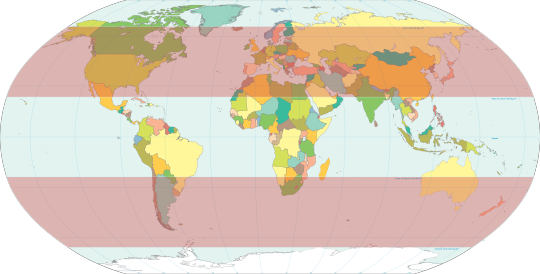
Here is a map of "temperate" latitudes, or rather, latitudes between the tropics and the polar circles (as someone who lives here, or indeed an Australian can tell you, many places there are not "temperate" at all but more on that below). What is important here is that the southern hemisphere has less places closer to the pole, except, again, Antarctica, while the northern hemisphere has lots of land near the poles. This is why we don't have our equivalents of say, Siberia, for example. The closest thing is again, Patagonia. Honestly an underused place for worldbuilding, with the steppe, the glaciers, the temperate rainforests, and the recently extinct megafauna, but I digress.
You could in fact have a tropical "north" if you keep most of the northern hemisphere's landmasses near the equator (here I'm picturing some kind of big Indonesia or Caribbean, an area where tectonic plates collide and there's lots of volcanic islands and lands), and you could place a big continent in the South to make it a cold South. Interesting reversal on the cold North/warm South of most settings.
This would bring some interesting effects, though. Placing a big landmass on any pole (not a small one like Antarctica) would lead to glaciation, as land is "colder" or rather less moderated by ocean (more on that later) and glaciers grow, and glaciers and arid land have greater albedo, reflectivity, that is, and so they reflect more sunlight, thus those place become colder, and the glaciers keep growing, and so on, until there is an ice-age. I don't have the link where I read it with me, but I recall that continents shifting to polar latitudes might have triggered ice-ages in Earth's past.
Deserts are very tricky to place. The standard worldbuilding recommendation is that the interior of the continents are drier as you get away from the sea, and that mountain chains and high terrain serves as rainshadows that stop rain from the sea. However, there is a lot more to it. A LOT more.
You can find deserts even next to oceans, in the so-called "horse latitudes", the meeting points of the Hadley Cells that circulate air from the Equator to the subtropics and beyond. The details are a bit technical, but what this means basically is that they create jet streams of circulating air at 30° South and North, keeping the climate sunny, warm and dry. This is indeed where many of the world's coastal deserts are: Atacama, Kalahari, and of course, Australia.
Meanwhile, in the equatorial zone, the "trade winds" (because they have regular wind patterns that have historical formed major sea trade routes, worldbuilding hint!) converge in the Equator, forming rainy areas... but not quite that simple.
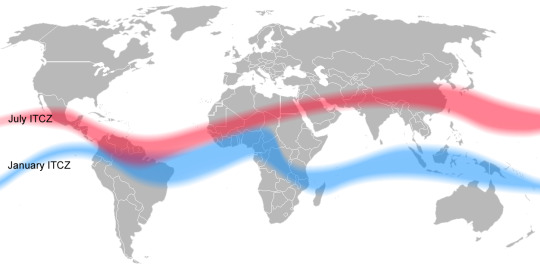
The Intertropical Convergence Zone, where these winds meet, ocsilates during the year, creating monsoons, but as always, there are lots of factors involved. In particular, given our real life scenario of rapid climate change and global warming, a warmer temperature means more intense ocsilations. This makes monsoon events sharper (more droughts and floods in those regions) and more strong La Niña/El Niño events, which are their own thing, influenced by the Pacific which is a huge factor in global climate.
And this brings me to ocean currents. Usually, being close to the ocean moderates the climate, making it more rainy and warm, or at least stable. However, if the surrounding sea is cool, it means less evaporation and less rainfall, especially if it's influenced by cool polar currents (this is the case of eastern Patagonia, for example, with the cold Malvinas Current). The opposite is the case in, for example, Europe, where the warm gulf stream moderates climate, making it warmer and rainer compared to the same latitudes in the US and Canada. I'll admit I'm not very well informed on how ocean currents work, but the depth and salinity of the ocean have much to do with it. What basically happens is that dense salty water sinks and and this works as a "conveyor belt" for warm less dense surface water to flow over it and over great distances. These currents are slow, but since the ocean is so massive, they move extensive amounts of heat across the world. I will admit defeat here and just say I don't wholly understand how it works, but I can tell you this; if your world has a less salty ocean, your currents will be less strong, which means that the differences of temperature between the poles and the tropics will be sharper as there are no strong currents to overall moderate temperature. If this is all too complex for you as it is to me, the quick cheat is just looking at this map: warm water flows from the equator, and cold water flows from the poles, and they create "gyres" around the oceans and the Equator, and cold currents contribute to colder and drier climates (note the Canary, Benguela and Peru currents, the Malvinas current is not shown for some reason...)
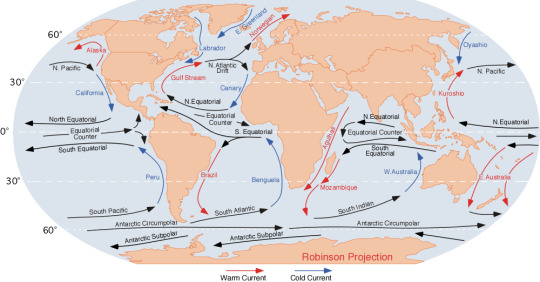
Did I forget something? Oh, yes. A colder climate of course, means less rainfall, because there is less evaporation and there is much water "trapped" in glaciers and snow. Which seems to be the case during the last ice ages. Rainforests and forests in general retreated as deserts expanded. In fact, the few forests that remained served as refugiums for species that only expanded again once the ice age was over. Some especulate that this might meant a 'weakening' of megafauna, as they were trapped in those refuges with lots of interbreeding and weakened populations when humans arrived on the scene. Here is a very interesting map:
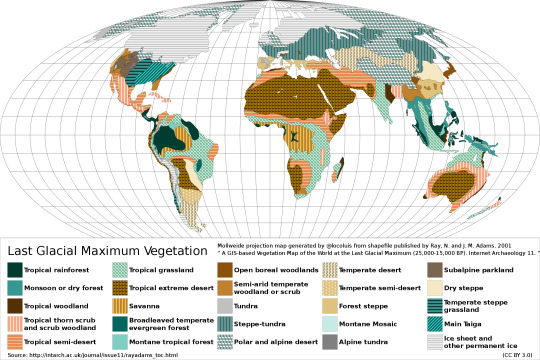
Now, there are some contradictions here and there, some researchers have said that the climate wasn't that dry and while I'm not an expert I tend to agree, many parts that are "extreme desert" there might be scrubland instead. But overall, it seems that colder times bring drier times too.
I'm still not done, but I'm almost done! According to the Biotic Pump theory, forests might also influence the climate and rainfall in a big way, basically, evapotranspiration (plants sweat, a lot, 90% of water through a plant evaporates to the atmosphere) in forests might actually create by itself the rainy environment where forests thrive, so for example, the Amazon is a rainforest BECAUSE of the forest there. I think with the increasing droughts here in South America we're seeing that theory proven in practice, as deforestation of the Mata Atlantica, the Chaco and the Amazon is causing less rainfall in the centre of the continent. Forests and plants also have a cooling effect, since they fix carbon dioxide, and also a bit of a warming effect, since they have darker albedo and so absorb more sunlight. I'm going to be very lazy and instead of reading a thousand papers say that they overall have a "moderating" effect.
Well, I could go on and on but I think I've already written way too much, so I'll leave you this to munch on a bit. It might seem like a lot, but when in doubt, you can always "eyeball" it by comparing real regions of Earth, and it will help you to create more interesting world than the omnipresent "spring-summer-fall-winter" temperate standard in so many settings.
If you have any questions, feel free to ask! Oh, and also, if you found this helpful or interesting, I would appreciate a tip to my ko-fi!
411 notes
·
View notes
Text
Ok season thoughts! Real quick, it seems easy to sort the MTG flavors into seasons:
White is spring (new life getting energy primarily from the approaching sun)
Green summer (lots of biomass, competition, eating each other)
Black autumn (things dying, fall leaves & berries, plenty of rot)
Red winter (bold take, but this is when you need fire to keep warm the most -- barring that, mantle is the greatest source of warmth)
and Blue is liminal, snaking through the gaps between other types, connecting them, smoothing the transition between them, possibly keeping them in order. It is the magic of the cycle. Of cycling.
Some Magic magic thoughts
Every so often I start thinking about why the land types in Magic: The Gathering are that and not something else. My thoughts today link the colors to important processes with regard to life. Here's what I've come up with (eternally tentative). It's all about energy and life..:
Plains -- Sun -- Sunlight fuels the vast majority of life on the planet. Most easily collected in fairly flat, open spaces with forb-ish plants. Other biomes where you can collect white magic fairly efficiently: Desert, Chaparral, Savanna. Also solar panels and blacktop.
Mountain -- Fire -- Geothermal. The little energy not ultimately derived from sunlight comes from the heat under Earth's crust. Most easily collected in life-scarce areas close to the mantle. Other biomes to collect red magic: Tundra, Taiga. Also at geysers, thermal vents, and volcanic-adjacent regions.
Forest -- Green matter -- Living processes. Lots of energy derives from eating organic material. Most abundant in areas rich in biomass and biodiversity, such as tropical rainforests. Other biomes to collect green magic: Temperate deciduous/evergreen forest, man-made Agrarian. Also whale falls, algal blooms, regions undergoing secondary succession, and high-concentration city centers. Swamps (and other wetlands), to some degree.
Swamp -- Rot matter -- Decomposing processes. Carbon, hidden from the frantic piñata scramble of life, can store plethora patient energy. It builds no-longer-life slowly, in a shadowed mirror of plants' build-growth from will-be-life energy. In the short term, it becomes a precursor for life fuel. In the long-term, it balances energy, sinking it from the realm of magic altogether -- only to be used with knowledge and magic-immiscible metal. Biomes collecting: Swamps, other Wetlands, Caves, and Soil. Also Urban garbage dumps and anywhere there is plenty of dead matter ready to be processed. Autumn.
Island -- Water -- Fluid convection (and water as solvent). Water holds matter and energy between its polar bonds, and its great lung carries life up and over, unliving but making possible life. Water moves. Water facilitates. Places to collect water: Aquatic ecosystems, polar ice, clouds, any water where life is present in rather small quantities proportional to the solvent.
Some notes:
Note: Water is an outlier in this conception (which differs from my associations! Usually I think of Swamp as the odd one out) in that it isn't a direct provider of energy to life. It carries and buoys, but no one uses water currents as food. I think this is neat!
Brings up a possible future rabbit hole of life figuring out how to evolve itself steam power...
LATER
(To be fair, Swamp is also an outlier in another way: None of the Platonic Terrestrial Ecosystems [I split it at trop forest, sub, deciduous, boreal, taiga, tundra, desert, chaparral, grassland, and savanna] are devoted to the type. Wetlands, caves, autumn, and dead things exist in every biome, and you can't really have a thing dedicated to only rot for very long. So Swamp is less its own thing and more of the awkward necessary shadow to everyone else. Is this how Hades felt?)
(Kinda cool it gets to be the transition between magic and metal, life and technology, though!)
(However, by that liminality logic, water outlies as well. Wherever there's cells, there's water. Only two things are certain in life...)
This creates an emergent dynamic of 2 element supergroups: Landholders and Liminals. White, Red, and Green primarily associate with particular areas, where Blue and Black collect in the spaces between. Swamp and Island are simply the terrestrial areas where you can get a decent distillation of the respective type.
Another kind of grouping also arises: Originators and Derivatives. White, Red, and Blue are all their own thing, helping drive life. Green and Black are the life (and death) that give all that stuff reason, direction. They're parents and children.
Relevant earth processes: Radiation, water cycle, carbon cycle, rock cycle, organic nutrient cycles & one-direction energy flow. I was thinking about these as I worked through the post.
Missing but worth considering: Phosphorus and Nitrogen cycles
You may want to associate Swamp with entropy, but that is a different thing. Entropy isn't accounted for in Magic. It would be interesting to come up with worldbuilding, and possibly mechanics, that would do such a thing.
Though this analysis does well accounting for these types and associated ecosystems, it doesn't engage at all with how the magic flavors behave mechanically. I'll be thinking on why those five behavioral classes are what they are.
That autumn bit gave me another idea: Magic types tied to seasons. Gonna reblog with preliminary thoughts on that.
#Never seen MTG particularly associated with seasons but I really like this take. It's elegant. Opposite seasons even have opposite colors!#Water also makes sense as being season-independent from an ecological standpoint#Oceans have a mitigating effect on temperature fluctuations#And an abundance of moisture basically gives you “nice early summer” weather pretty much year round#Though now this has me thinking of an alternate Wet and Dry magic system#Simplified MTG?#Temperate rainforest vs variable desert#Or tropical vs tundra#Not sure if 2 is enough to do anything meaningful with#But I'll think on it!#Something something pioneer vs competitive species#And being most viable at certain points in the game#I wonder what happens if I try to sort MTG types into different phases of ecological succession.....#4444
4 notes
·
View notes
Text



(Image description: three sketchbook drawings. The first is a sketch of a creature that resembles a very large olm, which is labeled a "wyrm". Next to it is an amphibious goblin for size reference, showing the wyrm to be roughly three times as long as the goblin.
The second image shows a sketched outline of a jaguar and then a sketch of a manticore with similar traits to the jaguar. The manticore is a variety that has poisonous quills in its long, curled tail, rather than having a scorpion tail.
The third image is a more detailed sketch of a dire elk in a field, with a small unicorn deer standing nearby. End description)
I've been trying to flesh out the creatures of my world! There are some limits I have set on myself because of the more grounded setting, but I still want to have fun and make the whole world feel fantastical.
Wyrms are an evolutionary cousin of the goblins. They are speculated to have some manner of magical ability, but it remains unconfirmed. Wyrms live in underwater cave systems or muddy lakes and bogs. Those who live in more muddy environments tend to be brown and grey while those living in cave systems tend to be white and pink. Like goblins, they have sensory barbels all over their faces, and a long sticky tongue to grab prey, as well as a resonating air sac in their throats that they use for vocal communication. Also like goblins, they are able to produce toxins in their mucus.
However, they do not seem to be sapient and they will consume anything they can get a hold of, including people like goblins, drow, and dwarves, or anyone else who gets too close to their mouth. Wyrms are eyeless and blind, but it is believed they can sense the flow of magical energy and find prey through it. They do have very slow metabolisms, so it is unlikely for them to attack unprovoked unless they have recently become hungry.
Goblins have modeled their death god after the wyrm and leave their own dead as offerings near wyrm dens, hoping the easy meal will keep the wyrms away from the living and that the offering will provide some manner of protection to their people, especially during a seasonal hibernation.
Many goblins also believe they can become wyrms, though the reason for it differs between cultures. Usually immortality is involved, though some cultures consider it a cursed form while others consider it a gift.
Moving along, the manticore is a predator of the rainforest where the quetzalin, a bird-like people, reside. Though the manticore also preys on elves and any other creature it can find, the quetzalin believe it is a demonic creature created by the enemy of their own parental deity, specially made to hunt them down out of spite.
Even so, some young quetzalin are reckless enough in the courting season to pull stunts around the manticore just to show off to potential mates. It usually doesn't go as planned.
Manticores have sharp thick hairs in their tails and along their spines, similar to the quills of a porcupine. Their saliva is quite toxic, and they cover their claws and quils in it evey time they groom themselves.
And last, the dire elk and unicorn deer. Dire elk are basically the only large ungulate left in the temperate forest region they inhabit, because the presence of the centaurs pushed out so many other animals. Dire elk were able to compete because of their size and impressive antlers. Farther to the north, there are still moose and caribou, and out eastward in the grasslands there are many bison. But the dire elk has carved out a niche for itself and no other large ungulates overlap with its territory.
The unicorn deer are much smaller than the dire elk and have a fur pattern that looks similar to the dire elk calves, mimicking the babies for protection. Unicorn deer are capable of using magic, so it is forbidden to hunt them in case their use of magic is a sign of sapience. They warn the dire elk of predators, flashing a light from their single antler. But if they feel endangered they will also turn on the dire elk and even injure them just to create a literal meat shield between themselves and the predators.
#mm world details#writeblr#mm illustrations#sketchbook#fantasy creatures#wyrm#manticore#dire elk#unicorn
24 notes
·
View notes
Text
someone asked me what constitutes northeast Georgia given the shape of the state is sort of smooshed in at the top right-hand corner, so here is an opportunity for me to get excited about northeast Georgia, which is more a geologic distinction than anything bc it's about which counties have got the blue ridge mountains in them, basically.
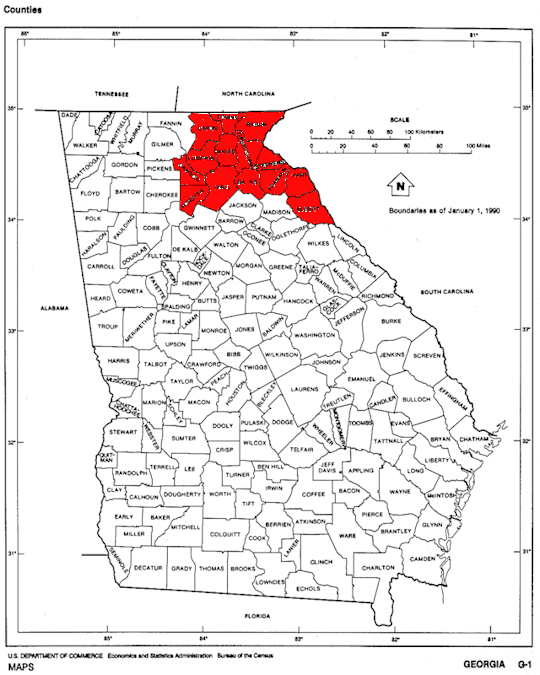
things I learned reading this wiki article: "The Adult Swim animated series Squidbillies takes place in Dougal County, a fictional county located in the North Georgia mountains" weird of them to invent a county given that we have an actual real county called LUMPKIN COUNTY but who am I to criticize
it's like a very specific area of the state mainly bc the isolation caused by the mountains meant that southern Appalachia was quite culturally isolated for a long time. :) so there's a lot of really hyper specific cultural AND hyper specific ecological stuff going on here! we got such a variety of plants and animals and fungi. up in Rabun county they get more rain than almost anywhere else in the country because the mountains form a storm trap and Rabun county has these areas that are tiny microclimates of temperate rainforests. it is pretty much the coolest thing. it's a very neat area of the country!
also: yes, we have a famously stupid quantity of counties in Georgia and it is truly unnecessary but also kind of funny.
#ga t#i think regionally its technically Piedmont. which is a part of southern Appalachia#anyway#now u know#my mom's family has lived in this region for. a really long time. its an interesting place#i have some big & conflicted feelings about it as i suppose one might imagine
94 notes
·
View notes
Text
So I definitely think I want to retconn the general environments of Sornieth into something a little more grounded and realistic. I especially dislike that each flight is basically one huge chunk of land that's 1 entire biome, maybe 2-3 at best.
I like my worldbuilding with a healthy dose of realism alongside the fantasy, I think that contrast is really important to making the more fantastical elements of a setting pop. Take LoTR, Mordor is such an impactful setting because of how hugely it contrasts the otherwise realistic and even idyllic lands seen elsewhere.
I think the angle I want to take is to have each flight be based on a certain sort of climate, with a mix of different more specific biomes that are largely based on real-life biomes. To contrast that each flight has different anomalous effects on the environment. So if you're going on an adventure through the Starfall Isles, you might be mostly passing through pretty fields of flowers, mountains and temperate rainforests only to stumble across a grove of glowing trees and crystals.
I think I have a reasonable idea on what sort of climates/biomes I want to base each flight on, some will certainly stray from canon more than others. Sure earth can still be deserts and canyons, but plague? There isn't exactly meat fields in real life that I can draw inspiration from...
#fr#flight rising#if you were wondering I want to base plague on ''harsh'' landscapes like australia's outback or the african savannah#places that have a reputation for being difficult to survive#also i think plague would be very hot and dry
16 notes
·
View notes
Text
I have already decided after just 1 day of trying to keep a travel diary that I cannot be one of those people who writes up a diary entry in the evening that summarises the day's events. it feels too contrived & navel-gazey for me, so I'm probably just gonna keep existing in the moment, and log things as and when they happen
that being said, I have details from yesterday that I already typed out so will quickly eject those here (includes nature/scenery photos):
- on the overnight coach from London to Glasgow I, as predicted, did not manage to sleep at all. we stopped at 5am at motorway services, which in England is probably actually the least depressing time to visit motorway services. my overwhelming feeling was that I missed Australian servos where you can just buy a hot pie at any time of day or night (was suddenly whisked back to that time I bought one described as 'breakfast pie' on a coach stop in the middle of nowhere in the very early hours, and every bite presented a new revelation: oh it's ham & melted cheese... oh wait there's minced meat and gravy in there too... wait... a boiled EGG??)
- sadly, upon arriving in Glasgow, a latte & pain au chocolate from Costa had to suffice. I had 2+ hours until my next coach, so I finally knuckled down and got on with some work
- main observation from the coach drive to my next destination: there are a lot of rhododendron trees growing along the roadside verges on the Glasgow -> Loch Lomond route, and beyond. pretty yes, but it's invasive and clearly out of control in these areas. I just know my mum is gonna have summat to say about it when she gets up here 😅
- it was raining & misty as we drove up along the loch, so it was all looking quite atmospheric - quick snap from moving coach:

- I finally managed to snooze a little on this drive
- then we arrived at the west coast:

- eventually arrived at my hostel at 1:30pm, check-in not until 5pm so I resumed working. Finally finished work at 4pm, then went to make a brew
- within 15 mins, I'd befriended a French guy called Mathieu currently working at the hostel who offered recommendations on nearby islands to visit, gave me a chocolate from the staff cupboard, taught me a new French phrase (péché mignon: guilty pleasure) and invited me to karaoke in the evening. His dream is to buy a farm in Scotland and have horses... "But the problem is capitalism." You're not wrong there, Mathieu
- girl at check-in asked to see my ID (standard procedure) then exclaimed "'89??!! I was checking to see if you were an adult!" It's been a while since someone actually mistook me for a child but she smelt of weed so maybe being stoned was a factor
- I am sleeping in the exact same bed I was assigned when I last visited 2 years ago (I will be more specific about which town when I have moved on to the next place, given this is not a private blog)
- then befriended a girl in my dorm and we ended up going food shopping together, after which I decided I should go for a proper walk along the water. By this time it was early evening but at this time of year it stays light until 10pm this far north so I didn't have to worry. I ended up hiking up a steep hill and wandering through a small pocket of ancient temperate rainforest, just following a trail with no idea where it led... basically my absolute ideal walk
- here are some photos of trees, mosses, ferns, and fungi (including a massive one, maybe the biggest I've ever seen):







- according to the Merlin bird app, I could hear goldcrests and chiffchaffs (both are uncommon), wrens, coal tits, and chaffinches as well as the usual robins and blackbirds. I saw them all except for the chiffchaffs
- eventually got back to the hostel at 9:30pm, ate the last of my chicken fried rice that I made a few nights before and brought with me, and sat nursing a decaff tea while people in the living room watched Shaun of the Dead projected on the wall
- eventually accepted at 10:15pm that my body and brain were both completely exhausted from all the physical activity & complete lack of sleep over the prior 36 hours, and hauled myself to bed. safe to say @jmflowers, who had already told me to do exactly that, knows best
#Cake's travels#<- tag for you to blacklist if you're already like girl pls stfu#Janelle texting me at 9:55pm: ��you should go to bed”#me [paraphrased]: “at this time?? too early!! yolo!!”#me 20 minutes later: “fuck i should go to bed”
6 notes
·
View notes
Text
my room is starting to depress me a bit. i feel like your average ‘exotic wild animal that these rich influencers should definitely not own but it’s sitting on their counter with a collar anyway’.
any suggestions for ways to make my room feel more jungle or even temperate rainforest-esque? i don’t really want anything tacky but just to slowly transform it into something that feels more comfortable for an animal to exist in. some people line their walls with fake ivy but i don’t love the look of it
i bought a california prairie ecosystem poster i’m gonna hang up somewhere but other than that i’ve got basically nothing aside from the occasional bone, fur hide, bear carvings, etc.. all suggestions very welcome
136 notes
·
View notes
Text
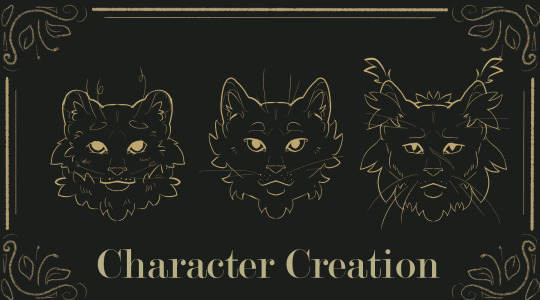
CHARACTER CREATION GUIDELINES
Characters that members nurture and bring in are necessary for the server and world of Ever Rain to develop and grow in unique ways, as characters interact with and shape the world that surrounds them. They create their own stories to be told and influence future legacies, and are the lifeblood that breathes life into the five Clans of the temperate rainforest. Ever Rain does not aim to stifle creative liberty, allowing for lenient character designs and a wide gamut of personalities. However, there are some basic guidelines to consider when creating your character!
────────────
NAMING CONVENTIONS
1. Three cats may share the same prefix. Once that prefix has filled its limit, it will be marked down as a ‘Closed Prefix’ in a designated channel. This is to prevent confusion regarding many multiples of the same prefix and mixing up character names.
2. Names follow the standard canon format. You may use hyphens for if the letter between the prefix and suffix is doubled, but no apostrophes or spaces between the names.
2a. The exception to this may be the usage of titles in Clans like Thornrush. These are not given lightly and are reserved for cats who have accomplished something great or acted with extreme selflessness. Examples of a title might be ‘Steadfast’ Exampleclaw, or ‘Duty-Bound’ Healerherb.
3. Wildlife and herb names are typically of British Columbia and Alaska inspiration, but for cats who have traveled far and seen much (such as a traveling kittypet), the exception is made. The cats of the pacific northwest won’t know what a tarantula is, but if added to their vocabulary and knowledge, the name may be sifted into commonly used ones.
4. Prefixes such as Gem-, Jewel-, or some sort of precious gem or mineral are allowed, and more odd names such as Zephyr- or Zip- are allowed as well. You are encouraged to get creative with your characters' names!
4a. Meta and joke names will be allowed within reason. If you present a wonderfully fleshed out and beautifully written character named Garfield. Well. You’ve earned it at that point.
4b. This does NOT include names that joke about serious topics or act as inflammatory.
5. Tribal names will not be used, and ‘Savage-’ as a prefix is not permitted to be used. This is to avoid anti-native racism or appropriation from being brought into the server.
──────────────────────────────
STYLE vs. REALISM & APPEARANCE
1. Ever Rain accepts a wide range of designs and style choices. Allowances include subdued or ‘tints’ of unnatural colors, as seen below showcasing blue, green, and purple undertones, as well as realistic art all the way to the other end of the spectrum with highly stylized, also seen below.
2. Intense and highly saturated colors are to be avoided, as well as neon colors. Essentially, Ever Rain does not accept sparklecats.
3. Unnatural eye colors are allowed within reason, again, as long as they aren’t neon. Heterochromia of all kinds are not barred or locked behind a paywall.
4. Regardless of what color the art is, you still must describe them realistically. Such as a black cat being tinted purple, would simply be described as a black cat with cool undertones.
5. Hairstyles are allowed, such as braids and so on. The Clans have the capability to craft clothing, they would likely be able to craft braids!

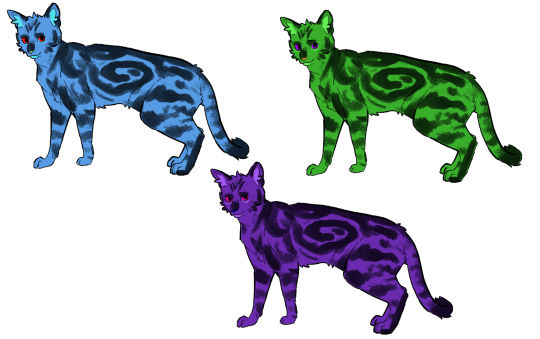
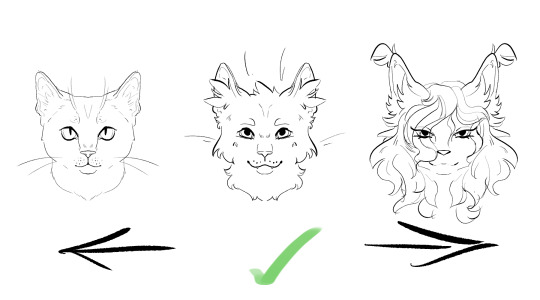
──────────────────────────────
PERSONALITY & HISTORY
1. A wide gamut of personalities are allowed within Ever Rain; it is open world, and realistically not everyone is going to be a saint or entirely evil. People have a wide range of emotions and values, personality traits, likes and dislikes, and so on. You are not going to be policed on the type of character you want to create.
1a. This does not mean creating a villainous character who is evil just because. What are their goals? What happened in their life to create this version of them? How do they feel about their negative qualities, do they feel remorseful as this is a necessary evil, or do they relish in it?
1b. Give your characters flaws! Even the best among us have them, they are natural and normal. How does your character handle their flaws? How have these flaws affected your character growing up? How will they impact your character as they get older?
2. A character's history will affect how they develop. How did your character's history shape them as they are today? These are all things to consider when creating your character!
3. You may not utilize anything found in the blacklist in your character's history. This is a strictly followed rule. Mentions of SA, self-harm, any sort of NSFW, graphic depictions of abuse, incest, are NOT to be used.
3a. You are allowed to utilize somewhat sensitive content in your character’s history, though. This MUST be vague and properly trigger warning’ed as to prevent people from being upset with the content found in your character’s history. Topics such as vaguely mentioned abuse (mental, physical, or emotional only. NOT sexual), bigotry, dysfunctional families, identity struggles, and so on are allowed, again, as long as it is presented very vaguely and does not go into graphic detail and in depth information. This is to keep people comfortable within the server.
3b. These above topics may not be used as shock value. This rule is highly monitored, and if something is found in your character submission that falls into the realm of too descriptive or not allowed, you will be messaged and requested to change it. If you fail to do so, your submission will be denied permanently.
4. With the above said, please bear in mind this is a collaborative storytelling server. If you play a character who is wholly unpleasant and ‘lone wolf’ish, do not push other people away who want to collaborate with you because your character has these traits. Find ways to include these traits while still being able to collaborate with others!
5. For backstories, each Opening will feature a specific focus as to have minimal ‘spawning’ in of character’s into the world. The first Opening Ever Rain will feature Clan cat only characters. Future openings will feature cats traveling into the area and joining the clans or being an antagonistic force. More information on this will be given out in each Opening.
6. You may create characters who have familial links to notable figures from the past. Do ensure that if your character romances another character, that they are not related through a shared historical family member.
──────────────────────────────
MUTATIONS
1. No mutations are locked behind a paywall. You are not required to purchase a mutation from a server shop. These include:
a. Albinism
b. Heterochromia (Any Kind)
c. Gigantism and Dwarfism
d. Polydactyly (Extra Toes)
e. Four Ears
f. Curled Ears, Rounded Ears & Folded Ears
g. Ringtails, Bobails, & No Tails
h. Polycaudal (Extra Tail or Split Tail)
i. Eyeless
j. Short Legs
k. Hairless & Patchy Hair
l. Chimerism
m. Curly, Wavy & Wiry Fur
n. Vitiligo
2. Mutations commonly associated with health issues do not require you to have your character be affected by these said health issues, though it is encouraged to look into it!
2a. For Example: A cat with the folded ears gene (Fd, fd+) will realistically have problems with development of the ears, joints, and bones. This can cause arthritis, spinal issues, thick tails or short legs. If your character has folded ears, you are not required to have any of the above afflict your character if you so choose. If you do choose to, you are encouraged to get creative with how your character deals with it! Arthritis might be helped by compression wraps or sitting in some hot springs, and spinal issues might be aided by a rudimentary brace!
2b. This does not include mutations or syndromes that are 100% fatal to cats that have them, such as kitten feline distemper, homozygous folded ears or manx genes, and so on.
If there is a syndrome or mutation that you are unsure about, please reach out to Staff and we will do our best to help figure something out!
──────────────────────────────
CONDITIONS & DISABILITIES
1. Conditions and disabilities, both physical and mental, are not locked behind a paywall nor barred from being utilized in character creation.
2. However, you are REQUIRED to research said condition, and play the character in a respectful manner. This is non-negotiable. Common issues that arise often come from complete misunderstanding of conditions such as DID or schizophrenia, with both often being portrayed as violent and scary. Another issue commonly seen is the complete infantilization of those who are autistic. If you are not familiar with said condition, please do your research, and understand that anyone with the same condition is not a monolithic entity.
2a. If your character is played in a disrespectful or otherwise unsavory manner due to a condition they have, you will be requested only once to fix this. A subsequent violation of this rule will result in your removal from Ever Rain’s server.
3. In conjunction with above, you are not allowed to roleplay ableism or bigotry towards a character who has a disability or condition, or otherwise has a targetable trait such as being LGBT or trans. This can often be triggering to some, or downright uncomfortable with most. This is not included under the ‘inside RP views do not equal outside RP views’ rule in Community Guidelines, as that refers to more political stances and feelings between characters, not downright discrimination between characters.
4. No cat will be forced into any specific role due to a condition or disability that they may have. (Ex. Cinderpelt becoming a medic due to her leg injury).
──────────────────────────────
IDENTITY
1. Identity refers to the character’s self and who they are. You are allowed to play a LGBTQ+ character or Trans (umbrella term) character, but please do so respectfully if you do not have experience with this in your personal life, and please avoid stereotypes.
1a. Stereotypes of the above may include trans women being portrayed as violent and crass, while trans men are portrayed as waifish and vulnerable, or that all nonbinary people are ‘AFAB +’. This is not to say that you cannot have a transfem character who is abrasive, or a shy transmasc character, but there is a notable difference between this and this but coming from a place of bias. Please just be mindful of how you portray your characters.
2. Intersex characters are allowed, but as above, please be respectful and mindful of how you portray your character, and avoid stereotypes.
2a. Intersex does NOT equal transgender. You can be cis and intersex, or trans and intersex. The two do not equal one another.
3. You can decide whether your character may be able to carry kits or sire kits, or be infertile. That is up to you!
4. Male calicos and torties are allowed, it is up to you whether you would play them as trans or not. Realistically, most male torties are sterile, but that rule may be bypassed in Ever Rain.
──────────────────────────────
ADOPTABLES & SLOTS
1. Once accepted into the server, you start with an extra character slot in addition to your accepted starting character that you may do whatever you wish with. This limit is lifted after a month of roleplay has passed, from there on you may create as many characters as you want.
1a. The month-long two slot limit is to allow everyone to get settled into the server and become familiar with one another, staff, and the overall setup of the server and world.
1b. This is also to prevent members from joining and creating a character for each Clan and overwhelming themselves trying to keep up!
2. With the above said, please only make as many characters as you think you can handle! If you feel comfortable with just one, there is no shame in that, and if you can juggle six characters, then by all means go for it!
3. Adoptables may be made both by staff and by members alike. Most adoptables will only be featured in-server for other members to pick up, but you can approach staff if you’d like them to be featured in an upcoming Opening!
3a. Having adoptables be featured in an Opening is an excellent way of allowing new members to seamlessly join into current plotlines and families, so do not be afraid to ask if you want to do this!
3b. As an Opening draws near, we will put out a bulletin stating that if you want an adoptable to be featured, now is the perfect time to submit them!
4. All adoptables require basic information to work with, such as a base personality, history, and so on. You are free to allow an adopter to choose as much as they like!
──────────────────────────────
NATIVE APPROPRIATION & RACISM
1. As stated at the start of the guidelines, Ever Rain will not be utilizing tribes or the tribal naming convention for any openings or characters. This is due to the insensitive fashion in which they are portrayed in the canon storyline
2. Medicine cats have been renamed, with Apothecary taking the main role, and medics and seers under their wing. Apothecary is still a title that was used in medieval Europe as someone who utilized both medicine and spiritual guidance, without the connection to native medicine men.
3. Feathers behind the ear are not allowed to be utilized in designs. This is once again due to insensitivity and appropriation of Native cultures, and the ‘Native Silhouette’.
Here is an excellent link that covers the issues with feathers and the Native Silhouette very well!
4. Please avoid allegories that are meant to mirror real life issues such as racism or colonialism. These are delicate topics that are typically not handled in a respectful way.
────────────────────────────
If you have any questions about the above, do not be afraid to reach out and ask! These guidelines are to ensure the comfort of server members, both regarding racial issues commonly present in WCRPs as well as disabilities being presented in a respectful way.
8 notes
·
View notes
Text
one thing abt having both pwhl vancouver and seattle is that bc they're so close, a lot of the geographically relevant branding options are basically the same 😅 the mountains, the temperate rainforest, the ocean, and so on. and one thing i might be a little cheesed about is if seattle gets all the mountain branding (which we've seen a bit of in the leaks) because the mountain views from pacific coliseum are so gorgeous
#most of the branding for the other teams isn't really geographically specific tho (you can make arguments for fleet ig)#so i wonder how it'll all pan out#pwhl
4 notes
·
View notes
Text
Primamorphs
This is an incredibly diverse Euconch group, with far more genera than I can possibly categorize currently, so I will focus on the more commonly seen species. They all share the same relatively primitive traits. They have fewer bones than other Mollichordates; their limbs contain small, rod-like bones connected by muscles and ligaments. This allows greater flexibility, but prevents them from getting very large. Unlike other Mollichordates, they only have one or two toes per foot.
BarkLumps:
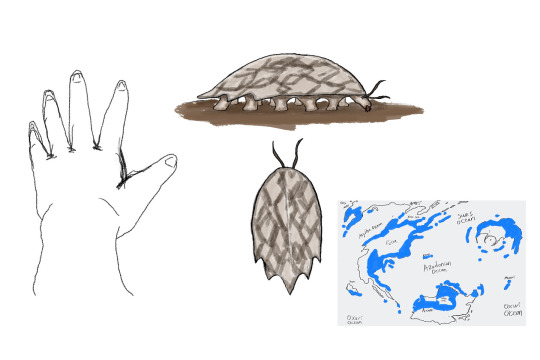
Pictured: the titan BarkLump, found in the forests of Maari.
These diminutive animals live worldwide, anywhere that there are decaying logs. With rasping mouthparts and ten little feet lined with suction cups, these creatures cling to dead trees and slowly scrape away rotting matter, feeding on the chitinous shells and the soft plant flesh within. There are hundreds of known species and potentially thousands of cryptic species waiting to be discovered with DNA testing. The species pictured here is among the largest BarkLump, nearly the size of a human hand, but most species are much smaller. The pattern on their shells mimic the trees that they prefer; this one is patterned to resemble the overlapping chitinous scales of Titanica trees.
Sapsuckers:
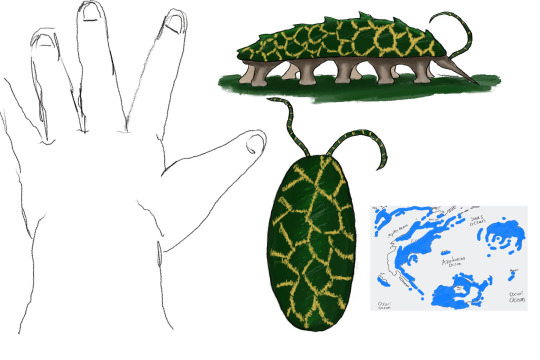
Pictured: The reticulated sapsucker, native to the labyrinth forests of Faon, is one of the larger species.
Similar to their cousins the BarkLumps, Sapsuckers are small animals that live their lives clinging to plants with the help of their many suction cup feet. But while BarkLumps eat decaying trees, Sapsuckers parasitise live plants. With the help of a highly modified beak, they insert their pharyngeal jaws into the vein of a plant and lap up the vascular fluids. Typically, the plant is unharmed by this annoying companion, but blooms of these little animals can kill even the giant Titanica trees. While many are roughly the size of the species pictured above, Sapsuckers that can easily fit on a fingernail can be found living in grassy plains and Limia carpets.
Leafies:

Pictured: the palm leaf mimic, an arboreal species living in the lush canopy of Ejoa rainforests.
Named for their incredible mimicry, these omnivores have their greatest diversity in tropical forests, but a few species can be found living in more temperate areas as well. Species which live in drier climates have shells that mimic the fat, water-filled leaves of arid plants, and species that live on the ground resemble dead leaves. They spend most of their time swaying gently with the wind, waiting for small Hexapods, BarkLumps, or Sapsuckers to venture too close and be grasped in their tiny clawed hands. They also feed on fruits, nectar, and even occasionally leaves.
Scuttlers:

Pictured: the wooly Scuttler, found in the tundra of Amki.
These elusive animals are more frequently heard than seen, scuttling around in leaf litter or the tangled roots of savannas. Eating essentially anything they come across from animals to plants to decaying matter, these are like the little vacuum cleaners of the forest floors. They are a keystone of the ecosystems, providing food for many other species and cleaning up their habitats. They are found basically everywhere except extremely arid deserts and mountaintops.
Marsh Eyes:
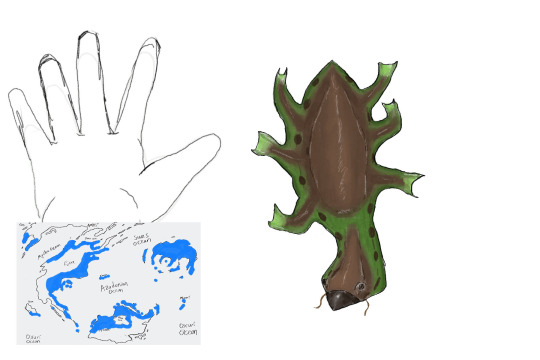
Pictured: the spotted lumpfrog, native to the Three Lakes region of Ejoa.
Semi-aquatic and skittish, these creatures live in ponds and swamps around the world. Their bulging eyes positioned on the tops of their heads are frequently the only thing you see of them before they vanish beneath the water. With webbed feet and thin, slimy skin, they are almost like an alien frog. Unlike frogs, they feed primarily on marsh plants, with occasional Hexapods and tubies as a protein source. Their shells are highly reduced to allow more agility underwater, but it can still be seen as a hard lump just under the skin.
Land Flounders:

Pictured: the Hyranese pancake, an average-sized land flounder from the deserts of Hyra.
Just like their aquatic namesake, land flounders bury themselves just beneath the sand of desert regions with only their eyes sticking out. There, they wait until something small enough to fit in their mouth wanders into reach. Their pharyngeal jaws are highly extendable, able to shoot out nearly twice their body length, and coated with a sticky mucus almost like a chameleon tongue. After a big meal, they can go months without needing to feed again.
48 notes
·
View notes
Text
The Kirakh (REVAMPED)

Introduction
The Kirakh were a 13 ft tall reptilian alien sophont race hailing from the Xyke System, a star system similar to ours in the Andromeda Galaxy, orbiting around a K-type variable star. They are currently a type 2 civilization on the Kardeshev scale, having colonized two other star systems in their stellar neighborhood, and is working on another one. Their empire consists of the Xyke system, where they come from, and has six planets, the Yyhakhe system, a nearby star system with eight planets orbiting around another K-type orange dwarf, The Raxycha system, a star system with ten planets around an M-type red dwarf, and the Tyxoo system, which is a binary star system with two M-type red dwarfs and twelve planets.
The species is currently recovering from a devastating world war that temporarily crippled their planet way before they decide to venture to the cosmos, about 100 years ago, approximately. They also have a long history in relative to their star's long lifespan.
The Kirakh evolved from tree-dwelling omnivores that fill in the niche of a squirrel/monkey from a rainforest in whats now the Great Zoghese Desert.
(huge wall of text warning)
Species
The Kirakh are divided into two species, the Northern Temperate which originate from the Natikan continents of Talyke and Sanland, and the ones that originate from the rest of the world. The Northern Temperate Kirakh are classified by their unique ability to antifreeze during the long, sunless winters.
Anatomy
Physical Appearance
The Kirakh have a total of three pairs of limbs, with the midlimbs and the rearlimbs being functioned for walking, while the remaining forelimbs being used to manipulate objects and items.
Unlike humans, which have pentadactyly digits, Kirakh have tridactyly digits, meaning they posess three fingers on each limb. The digits on the midlimbs and the rearlimbs have been arranged in a chameleon-like form, with two digits in the front and one in the back, and reverse in the rearlimbs.
Their forelimbs have evolved to become three-fingered hands with opposable thumbs that allows them to manipulate and interact with the world around them, as well as retractable "hooks" in their digits that is once used to hook onto the surface of the trees and help be better at climbing.
It appears that the rearlimbs on the Kirakh are facing backwards unlike the other two frontal limbs. Of course, this is a universal trait for some backboned creatures on the planet, which they take from their ancestors millions of years ago.
The Kirakh also have gold patterns that range in opacity and varies from individual to individual, that they oftentimes use to tell each other apart. There are actually hundreds of gold pattern variations.
The Kirakh mostly exhibit some sexual dimorphism, with males being more likely to have wider eyes, bigger cheek horns, a more larger more flashier crest, and a more wider gold pattern variety, but being smaller than females, while females are more likely to have narrow eyes, smaller cheek horns, smaller crests, and a more limited gold pattern variety and are more bigger than males.
Some parts of the Kirakh skin, such as the face and the limbs, are made out of the same leather human skin is made out of, with a layer of keratin scales going down from the nape to the section where the tail meets the body. The Kirakh also have feathers under that layer of scales that cover most of the body, usually shorter and more rougher when in warmer regions to and longer and fluffier in colder regions to preserve body heat.

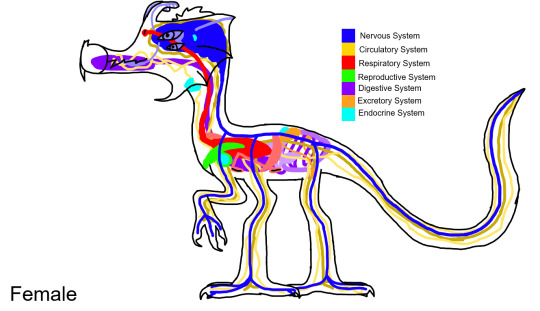
Nervous System and Senses
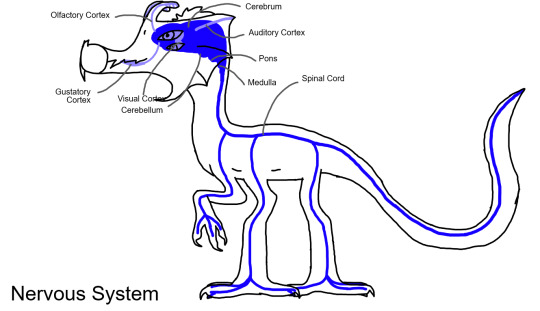
The Kirakh have developed a large brain for complex problem-solving abilities and had evolved to be the sophont species of their planet. The central nervous systems consists of the following:
The cerebrum - Most of the basic functions like consciousness, speech recognition, etc.
The cerebellum - Movement co-ordination
The Pons and Medulla - Basic vital functions eg breathing
Their senses - Like the Olfactory Cortex (smell), the Auditory Cortex (hearing), the Visual Cortex (sight), and the Gustatory Cortex (taste)
Kirakh eyes function similarly to human eyes in that they are composed of a lens and retina. But, while humans have three color cone cells, Kirakh have four, and they can detect colors from anywhere to reds, greens, blues, and far into the ultraviolet range, which means their vision can be equivalent to Earth bird vision.
For example, the hard skin of some common temperate Natikan fruit would be dull colored according to human vision, while it would be a bright ultraviolet color according to Kirakh vision. Generally, certain colors might mean certain things for the Kirakh, a delicious fruit would range from bright colors like ultraviolets to blues to greens according to the Kirakh, while a red or dull color might signal them to stay away or don't eat.
Kirakh smell with their antennae, which were the long-to-short appendages on their forehead. These antennae were external olfactory bulbs, which at the tip can open to show sensory cilia, which can detect scent particles, and can retreat back into the antennae when not in use.
One thing is to be noted is that the Kirakh can smell things that humans can't smell, for example, the smell of sand, or the smell of tasty fruit (wait can humans smell fruit??).
Their earholes are actually in the giant crests that the Kirakh use to express themselves, there is one pair of earholes on the top crest though, the two others are only for show. The Kirakh can only hear in ranges of 0 decibels to only 100 decibels. For example, the Kirakh may think that human music is too "deafening" or "loud" and can temporarily make them deaf for some minutes, which is why they favor more slower, more calmer music.
Circulatory and Respiratory System
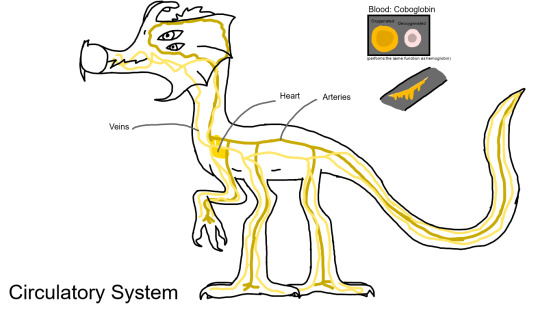
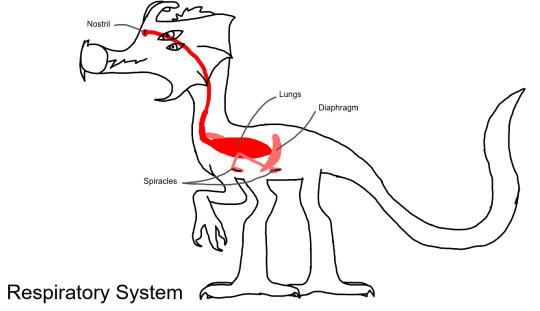
Kirakh blood is made up of coboglobin, which replaces the iron atoms with cobalt atoms, and it performs the same function as the hemoglobin found in humans. It makes their blood amber yellow in the arteries and clear in the veins.
Every 24 Earth hours, the molecule would have worn itself out, and it would change from it's usual amber yellow color to a deep pink. Thankfully, the Immune System would send special cells to take care of the problem, although there are some instances when the Kirakh gets older and their immune system becomes too weak to send these special cells to pick up dead blood cells. This might be indicated by their unusual deep pink blood color.
They would need double the oxygen intake because of that, so they have three pairs of breathing holes, the first pair is located on the forehead, in front of the antennae, while the remaining two pairs are located along the sides of their body. The first pair is also useful for when the individual is swimming and the four spiracles on the body close, to avoid water getting in the lungs, but it also needs to breathe too, so they would have one extra breathing hole on their head.
Digestive and Excretory systems

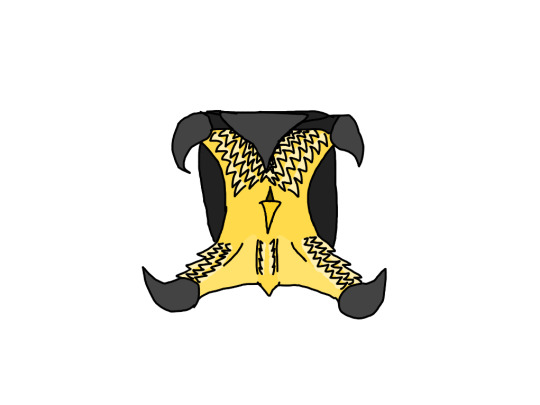
The Kirakh mouth consists of five "teeth" on their jaws, which is used to break through the hard skin of certain fruits (The skin is also somewhat edible for them). And in the maw there are a bunch of tiny teeth for chewing food. Their bottom jaws are split into three sections, once used to net insects into their mouth. They can move each section individually.
I forgot to put this on the mouth image, but there is a choana on the roof the roof of the mouth that connects to the nasal passageway.
They also digest and eat food similarly to humans, but with a crop organ that can store food for digesting later. Eaten food will wait about 3 hours before moving to the stomach to be digested. However, in females, the crop can be used to produce crop milk, which they use to feed their young.
Endocrine and Reproductive Systems
!! warning: mention of genitals and kinda detailed !!
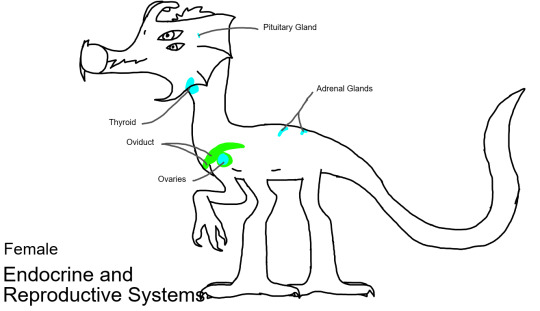

The Kirakh have a pituitary gland, the master gland, that can secrete hormones that can control growth, blood pressure, and many others. I didn't list it in the diagrams, but they also have a pineal gland in the brain that can secrete melatonin and regulate their sleep cycle, which will be explained later.
They also have a thyroid gland in their throat, which is necessary for controlling their metabolism, the rate at which the food is used. They have a pair of adrenal glands on the top of their kidneys which can secrete the hormone adrenaline when in times of crisis or hard exercise, much like humans.
What's not much like humans is how they reproduce. While human egg cells are fertilized internally, Kirakh egg cells are fertilized externally. This is because the reproductive organs are located in the chest cavity, and it might be hard for the young to develop internally inside the mother.
Females produce ovum, or unfertilized eggs, once they hit sexual maturity (which is the age of 15), and they might wait inside the oviduct until use. Males have a hemipenes, which is inverted, and they can evert for fertilization. They produce millions of fly-sized flying gametes with genetic information stored inside. The Kirakh egg is spherical, with a round capsule on the top, which is open before being fertilized, and once it is it will start forming a hard material around the capsule, which will keep the developing young inside safe. Gestation period will last 6 Natikah months before hatching into a young kirakh. Below is a kirakh egg.

As mentioned before, female Kirakh can use their crop organ to produce crop milk to feed their young. This can be seen in some Earth birds, like pigeons, doves, and other birds.
Behavior
Thermoregulation and Circadian rhythm
Being cold-blooded creatures, The Kirakh are sun-loving and are strictly diurnal, being active in the day where sunlight is plentiful. Kirakh may bask two times a day, one in the morning when they just woke up and may not have any energy in them, and one during the afternoon, when the sun is high up. Then they will go to sleep when the sun starts sinking below the horizon.
However, in the Northern Temperate area of the planet, it will be always day during the summer and it will always be night during the winter, and during the winter, the Northern Kirakh have a specialized anti-freeze stimuli that activates, sending them to a deep sleep that lasts till the sun starts appearing in the sky. This special stimuli is not in the rest of the world though, because there is always periods of sun all-year long.
Family Structure
Most cultures and ethnicities of the Kirakh practice polygamy, where one individual might take up multiple mates at the same time, usually about 2-6 mates per usual. They would eventually make extended tight-knit family groups, called yikha in their dominant language, which is made up of the leader's mates, their children, and their children's mates and grandchildren, and so on, and sometimes, the leader's or mate's siblings would be included in the picture.
One problem is that it sometimes gets a little bit too overcrowded, which is why Kirakh sometimes kick one of their yikha members out, either to live with another yikha, or to start their own yikha. There were polygynous families, where the female is usually the dominant leader, and the more rarer polyandrous families, where the male is usually the leader. I might describe the yikhas in depth in a future post.
Growth Cycle
Juvenile
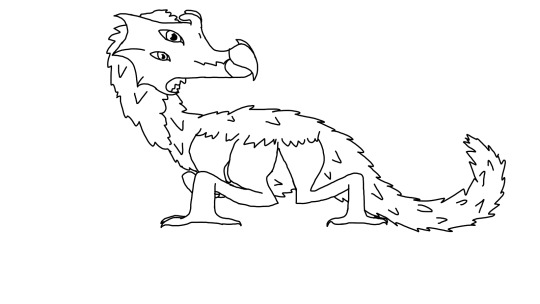
The average Kirakh would live from around 90-150 years
The Kirakh start off as hairless, have improper antennae, have wide, sprawled out legs, and feeding off of their mother's crop. They will later grow a coat of fluffy, downy hair, and will learn how to walk or crawl for a little bit a month after being born, but they will still feed on crop milk periodically. Eventually, when they are a year old they would have stood up for a bit and have been weaned, and they are considered to be good at doing most things on their own. Juvenile Kirakh would most of the time get an education at age 3.
Their metabolism rate is also high at the juvenile stage which means their thyroid gland enlarged, and will get smaller the more older they get, and their legs get more erect the older they get.
Adolescent/Adult

Once they hit a certain age, from around 14-15 years old, their downy hair will fall off to make way for feathers, and a large space on the spine for the keratin scales to grow, which will take 6 years, and by that time when they are 21 years old. They will also hit sexual maturity at age 15, but they are considered to be fully mature when they are 21 years old, meaning that they can do anything on their own without a parent.
Kirakh would start getting old from around 70-75 years old, which means they will have a slower metabolism, chipped scales, paler feathers, and a weaker immune system.
2 notes
·
View notes
Note
Are they named after trees and plants and such? Idk seemed familiar
Some are, yes! :D Long post ahead. :') So simple explanation but dragons are keepers/protectors of their region, which could be a section of a continent or an entire planet. Depends on the dragon's experience and size of region/planet. Now, humans have sometimes named dragons, and those names stick. Humans don't know about all dragons, so you'll have some with more complicated names. Tessa's name? Not her actual name! No one would be able to decipher it. ;) Here's a conversation between Niven and Tessa:
“Did Methla teach you how to talk in human tongue? And what is your real name?” Nearly all the humans who had ever heard the language of dragons lived thousands of years ago. Not even priests and priestesses could claim they had ever heard it.
She responded to the last question first, using a guttural noise that filled the air like the rush of a waterfall. Niven had to clap his hands over his ears. Despite that, he grinned.
“And yes, I learned your language from Methla,” said Tessa casually as he lowered his arms.
“Humans could not speak their names, and so placeholders were found.” Niven paraphrased the common knowledge all children learned in the nursery. He giggled. “Does that mean you didn’t know we called you Tessa until Methla told you?”
Tessa snorted so much that it created small waves in the water in front of her. They lapped against Niven’s rock stack.
“It’s a simple name, yes. So is your language. It has had so much time to evolve, and yet you have not the words for some emotions, no word for the tickle of a tail touching scales.” Her lips curled into what must have been a dragon’s smile.
Anyway, humans sometimes go with "what a dragon seems keen on" too. One of my dragons, Dirkka, likes... Dirks. Swords. Knives. Sheathes. (Dragons, hoarding? Yes haha~) Mind, he's equally touched when humans offer him sentimental items of no monetary value, like their children's first cut locks of hair. My art post included Bircha, for instance, and the birch tree influence. I'm glad I finally got to draw him. That led to a funny convo with a friend, who didn't know the word for birch tree in English but still sent me a picture of birch trees to say Bircha reminded her of them. :') Afensi isn't really in a fen, but it's a marsh-like area, and I came up with a name around "fen" easiest. Mydas is interesting, because if you look at his design and hop on google images to search "mydas"... okay wtf I'm getting bugs now, I'll add "sea" - AH THERE WE GO:
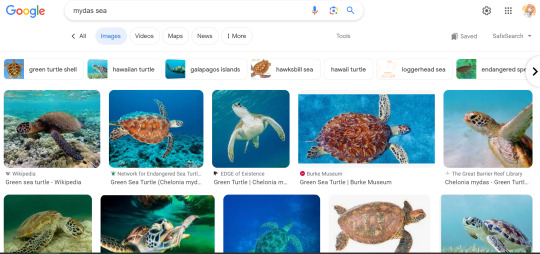
(Apparently google has figured out I like to identify bugs, so that must've skewed my results.) Mydas is the name of the planet he built, and the seasons are divided by sea turtle breeding patterns. (Which aren't super realistic, based on my research, but it's a fictional world/that's the system I wanted.) I also have Tempra, who looks over a region called the Spicewood, and it is a temperate rainforest! So yes, location/plants/etc usually do have a lot to do with their names. Just not for all of them. There are a lot of planets. Dragons have had planets destroyed on them (main plot of The Hostile Credence, and it's an unfortunate ending to the planet the first story, The Will of the Whispering, takes place on) and have to rebuild, or they go work on a new one, what of it? Their looks often change if their tastes do. :') They're basically a bunch of artists having a blast with building planets in space together. They also make space highways by the time humans start traveling in space. :D Some are named really affectionately, I think that's where Affie's name comes from. She's about the size of a bobcat, maybe slightly bigger, and just walks into random houses in her region and spends the night. Basically like a neighborhood cat that no one owns. She accepts wine offerings. So drunk aunt cat who crashes at random houses? (They love her, and she's one of the most commonly seen dragons on that planet, whereas others are elusive. No one actually knows Vionne exists.) I love talking about my dragons so much, sorry for the huge reponse haha
#also I love that I can sort of throw geography rules out the window to some extent?#like where temperate rainforests usually grow for one#the Spicewood is not located on a part of the continent where it makes sense geographically
3 notes
·
View notes
Note
❤️ Happy WorldBuilding Wednesday! ❤️
What are your cities or towns like? Feel free to talk about the layouts or the people or the architecture, etc. and to talk about more than one if you'd like!
ok so a significant portion of DaDBaB takes place in the city of Andalor* which is the capital city of the world-encompassing empire.
It's got a canal system that kind of separates the city into different neighborhoods (imagine boat traffic on main throughways but you can't get everywhere by canal). It's not directly coastal, but sits on a large estuary/bay (so like Seattle or Washington D.C. or Buenos Aires).
Kind of a temperate rainforest climate, so lots of rain and doesn't have very cold winters or hot summers. Lots of ferns and small ornamental trees in the nicer areas. Imagine lots of white limestone buildings in the downtown/center. An assortment of different architectural styles/materials as the city kind of sprawls out away from the older center/away from the water (This is by far not the biggest or oldest city in the world, but it is big and it is old).
It's also very diverse. Being the capital and fairly central geographically and also very accessible by ship or road or train. The current imperial family is Firanese, and Andalor is technically on the very south end of Firaney, so we get a lot of that influence aesthetically and culturally (think southwestern europe ISH) but population wise more of the people are actually Taqa (which tracks bc Jura Taq is the most populous country and the birthplace of our empire's lingua franca). But anyway the city kind of has it's own distinct culture/identity separate from the region like most people from there just think of themselves as Andalor natives rather than being Firanese or anything.
Andalor was a religious center before it was a political one, so its centerpiece is a very large temple (that I have yet to give a proper name oops) that is basically a bunch of concentric rings. When the empire moved back a few generations ago, they vacated everything on the hill opposite the temple to build the new seat of the highking/the central government etc. The issue is that it's seen as impious to build anything that takes up more space/land area-wise than the temple, so in order to build something large and grand enough, they had to get creative. Which is why we have a grand feat of architecture and engineering that is slightly smaller than the temple in terms of square-footage (on the ground floor) and is. very tall. (don't think skyscraper bc remember this thing is plenty wide also)
Anyway and that's where Lya lives as a permanent guest of the highking. (On the ninth floor but do not worry—elevators were literally invented for this building)
*all names in this draft are the product of me winging it completely and are subject to change
#second chance wip#worldbuilding wednesday#not me just throwing out place names left and right like everyone's been studying my map#also thanks for sending me asks even when I don't answer them <3 you are the backbone of this community seriously
3 notes
·
View notes
Text
as someone involved in conservation in the uk?
yes. this is entirely and heartbreakingly true. all our land is managed and overmanaged, successive governments continue to cut down on protections for national parks - labour are talking about a planning permission change that will allow developers to basically massively pressure planning committees into letting them do ‘less bad’ developments.
and those few pockets of broadly farmland with a few small patches of moorland or temperate rainforest are the closest we’ve got to what the landscape /should/ look like.
this is the most nature depleted country in the world, and what’s worse is that it’s been so exploited for so long that people don’t even realize it.
there are people working to fix our awful relationship with nature, but part of the problem is that rural areas have no industry other than limited agriculture or fucking pheasant shooting (and other forms of shooting) and so any changes are massively resisted by those communities (and if you’re involved in conservation, those are your neighbors, your friends!) so attempts to reintroduce native species are massively blocked and railed against until either they fail or someone decides to - illegally - take matters into their own hands and that also tends to end badly.
anyway it sucks! and im just some guy who volunteers for a conservation charity in one small patch of the island! this is not what this country should be like!
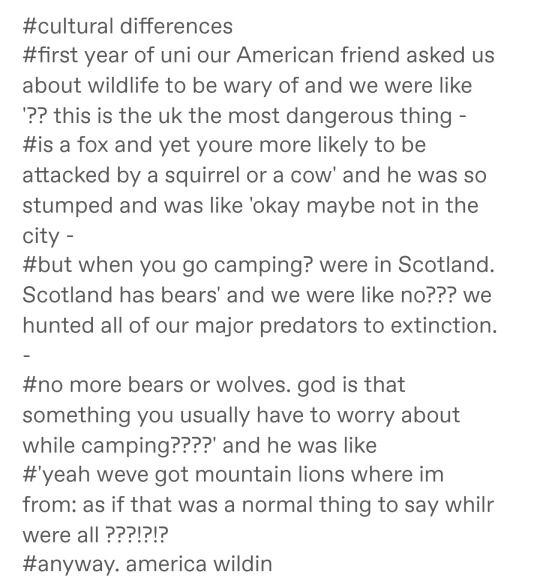
Actually your society is the freaks for shooting everything that moves and burning half your "nature reserves" every year so that upperclass dandies can eat leaded pheasant. North Americans are the well adjusted ones here, your country has become a desolate suburban lawn in island form
100K notes
·
View notes
Text
Oh cool. This is the first time I've ever gotten a wildfire warning in the area where I live. We're basically in a temperate rainforest.
0 notes